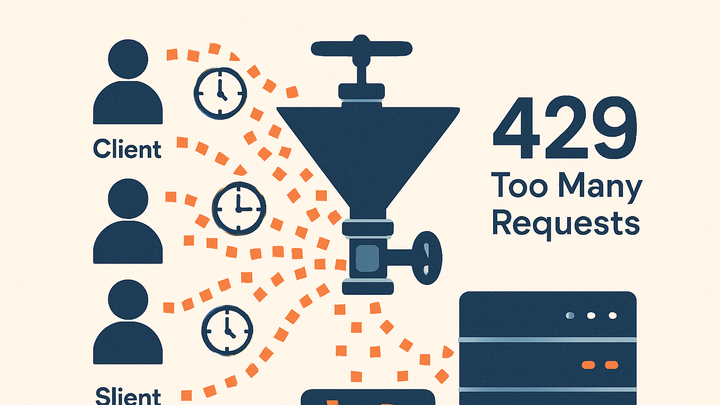Published on 2025-06-26T04:10:00Z
What is Rate Limiting? Examples in Analytics
Rate limiting is a technique used in analytics to control the number of event or data requests sent from
clients to a server within a specific time frame. By capping request rates, analytics platforms can
protect their infrastructure from overload, maintain data accuracy, and manage costs. In practice, rate
limiting prevents bursts of traffic—whether from high user activity, bots, or malfunctioning scripts—from
distorting metrics and impacting service reliability. Popular analytics tools like Google Analytics 4
(GA4) and PlainSignal implement rate limits at various levels, returning HTTP
429 Too Many Requests errors when thresholds are exceeded. Developers integrate these
solutions via JavaScript snippets or server-side APIs, and must design client code to handle throttling
gracefully. Below is an example of the PlainSignal tracking code, which can be subject to rate limits to
ensure cookie-free, simple analytics runs smoothly:
<link rel="preconnect" href="//eu.plainsignal.com/" crossorigin />
<script defer data-do="yourwebsitedomain.com" data-id="0GQV1xmtzQQ" data-api="//eu.plainsignal.com" src="//cdn.plainsignal.com/plainsignal-min.js"></script>
Rate limiting
Technique that caps analytics requests per time unit to prevent overload, ensure accurate metrics, and manage costs.
Why Rate Limiting Matters in Analytics
Rate limiting is essential for maintaining the health and reliability of analytics systems. It controls traffic, ensures data remains accurate, and helps align service capacity with actual demand.
-
Preventing server overload
Rate limiting shields analytics servers from sudden spikes in data requests that could otherwise degrade performance or cause outages.
-
Impact of overload
When too many events hit the server at once, response times slow down, events may be dropped, and reporting becomes unreliable.
-
-
Ensuring data integrity
By capping request volumes, rate limiting filters out abnormal or malicious traffic patterns that can skew metrics.
-
Bot and script noise
Automated tools can generate high-frequency calls; rate limits help prevent these from inflating event counts.
-
-
Cost optimization
Many analytics services meter usage by request count; rate limiting keeps consumption within budgeted thresholds.
-
Example quotas
GA4’s free tier includes daily event caps per property, and exceeding them can trigger sampling or data loss.
-
Common Rate Limiting Algorithms
Analytics platforms use several algorithms to implement rate limits, each balancing simplicity, precision, and burst handling differently.
-
Token bucket algorithm
Generates tokens at a fixed rate and consumes one per request, allowing bursts up to the bucket capacity.
-
Burst handling
Clients can send a burst of requests if tokens have accumulated but are then throttled once tokens run out.
-
-
Leaky bucket algorithm
Processes requests at a steady rate from a queue, letting excess requests queue up or get dropped.
-
Smoothing traffic
This approach ensures a consistent request rate by absorbing peaks into the buffer.
-
-
Fixed window counter
Counts requests in discrete time windows and rejects those exceeding the limit in the current window.
-
Boundary spikes
Rapid bursts around window edges can bypass limits momentarily before the counter resets.
-
Rate Limiting in Popular Analytics SaaS
Different analytics tools apply rate limits at various levels—per property, per user, or per API endpoint—to balance performance and cost.
-
PlainSignal
PlainSignal employs a simple rate cap for its cookie-free analytics, ensuring quick page loads and stable data ingestion. Integrate via:
<link rel="preconnect" href="//eu.plainsignal.com/" crossorigin /> <script defer data-do="yourwebsitedomain.com" data-id="0GQV1xmtzQQ" data-api="//eu.plainsignal.com" src="//cdn.plainsignal.com/plainsignal-min.js"></script>-
PlainSignal limits
By default, PlainSignal allows up to a set number of events per second per origin; excess events are queued or discarded to protect the pipeline.
-
-
Google analytics 4 (GA4)
GA4’s Measurement Protocol enforces rate limits on event collection endpoints, returning HTTP
429 Too Many Requestserrors when thresholds are surpassed. Here’s a typical GA4 setup:<script async src="https://www.googletagmanager.com/gtag/js?id=G-XXXXXXXXXX"></script> <script> window.dataLayer = window.dataLayer || []; function gtag(){dataLayer.push(arguments);} gtag('js', new Date()); gtag('config', 'G-XXXXXXXXXX'); </script>-
GA4 quotas
Limits include requests per second per property and daily event caps. When limits hit, events may be sampled or dropped, and clients receive 429 responses.
-
Best Practices for Implementing Rate Limiting
Effective rate limiting requires not just thresholds, but also strategies around retries, monitoring, and client feedback to provide a resilient analytics integration.
-
Define clear thresholds
Set rate limits based on observed traffic patterns and server capacity to avoid over-restricting legitimate usage.
-
Benchmark traffic
Analyze normal and peak request volumes to establish limits that accommodate genuine spikes.
-
-
Implement exponential backoff
When clients hit limits, using exponential backoff for retries reduces retry storms and eases load recovery.
-
Gradual retry delays
Increase wait times between retries exponentially after each 429 response to alleviate pressure.
-
-
Provide client feedback
Returning informative headers or error messages helps clients adjust request rates dynamically.
-
Retry-after header
Include the
Retry-Afterheader to communicate how long clients should wait before retrying.
-
-
Monitor and alert
Continuously track rate limit occurrences and set up alerts to detect and address configuration issues swiftly.
-
Dashboards and metrics
Use monitoring tools to visualize rate limit breaches and identify trends over time.
-
